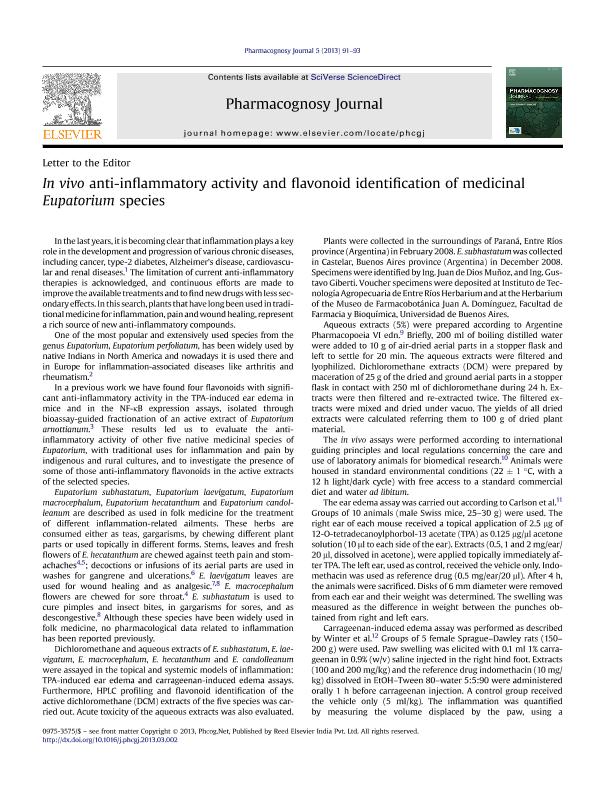Artículo
In Vivo Anti-inflammatory Activity and Flavonoid Identification in Medicinal Eupatorium Species
Fecha de publicación:
03/2013
Editorial:
Elsevier
Revista:
Pharmacognosy journal
ISSN:
0975-3575
Idioma:
Inglés
Tipo de recurso:
Artículo publicado
Clasificación temática:
Resumen
Eupatorium subhastatum, E.laevigatum, E. macrocephalum, E. hecatanthum and E. candolleanum are used in traditional medicine for the treatment of ailments related to inflammation. Their aqueous and dichloromethane extracts were evaluated for in vivo anti-inflammatory activity in the carrageenan-induced paw oedema and in the TPA-induced ear oedema tests. Dichloromethane extracts of the five species significantly inhibited the mouse ear oedema, being E. subhastatum, E. laevigatum, and E. hecatanthum the most active ones, with maximum inhibitions of 86.4, 89.7, 94.4% and ED50 of 0.35, 0.51 and 0.92 mg/ear, respectively. The dichloromethane and aqueous extracts of E. subhastatum were the only active ones in the carrageenan-induced paw edema assay, both producing a moderate oedema inhibition of about 37%. No acute toxicity was observed for any of the aqueous extracts at a dose of 2g/kg. DAD-HPLC analysis of the five active dichloromethane extracts led to the identification of the anti-inflammatory compounds jaceosidin, nepetin, hispidulin and/or eupatilin in these species. The presence of these active compounds in the DCM extracts could justify at least in part their anti-inflammatory activity and the medicinal uses of these species for the treatment of local inflammations.
Palabras clave:
Eupatorium
,
Flavonoids
,
Edema
,
Toxicity
Archivos asociados
Licencia
Identificadores
Colecciones
Articulos(IQUIMEFA)
Articulos de INST.QUIMICA Y METABOLISMO DEL FARMACO (I)
Articulos de INST.QUIMICA Y METABOLISMO DEL FARMACO (I)
Citación
Clavin, María L.; Redko, Flavia; Acevedo, Cristina; Martino, Virginia Susana; Gorzalczany, Susana; In Vivo Anti-inflammatory Activity and Flavonoid Identification in Medicinal Eupatorium Species; Elsevier; Pharmacognosy journal; 5; 2; 3-2013; 91-93
Compartir
Altmétricas




